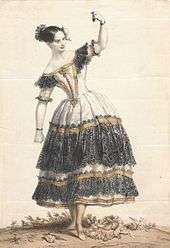Fanny Elssler



Fanny Elssler (German: Fanny Elßler; 23 June 1810, Gumpendorf – 27 November 1884, Vienna), born Franziska Elßler, was an Austrian ballerina of the Romantic Period.
Life
Daughter of Johann Florian Elssler, a second generation employee of Nikolaus I, Prince Esterházy. Both Johann and his brother Josef were employed as copyists to the Prince's Kapellmeister, Joseph Haydn. Johann was to eventually become valet to Haydn and attended Haydn up to and was present at Haydn's death.
From her earliest years she was trained for the ballet, and made her appearance at the Kärntnertortheater in Vienna before she was 7. She almost invariably danced with her sister Therese, who was 2 years her senior; the sisters studied dancing with Jean-Pierre Aumer and Friedrich Horschelt beginning when Fanny was 9 years old, also traveling to Naples to study with Gaetano Gioja. After some years' experience together in Vienna, the sisters went in 1827 to Naples. While there, she had an affair with Leopold, Prince of Salerno, the son of King Ferdinand I of the Two Sicilies, which resulted in the birth of a son, Franz.
Their success in Naples, to which Fanny contributed more largely than her sister, led to an engagement in Berlin in 1830. This was the beginning of a series of triumphs for Fanny's personal beauty and skill in dancing. After captivating all hearts in Berlin and Vienna, and inspiring the aged statesman Friedrich von Gentz with a remarkable passion, she paid a visit to London, where she received much kindness at the hands of Mr. and Mrs. Grote, who practically adopted the little girl who was born three months after the mother's arrival in England.
In September 1834 Elssler appeared with the Ballet du Théâtre de l'Académie Royale de Musique (today known as the Paris Opera Ballet), a step to which she looked forward with much misgiving on account of Marie Taglioni's supremacy on that stage. However, Elssler and Taglioni were exceptionally different dancers. Taglioni was known as a danseur ballonné, represented by the lightness of her leaps and jumps. Elssler, on the other hand, distinguished her dancing with the precision in which she performed small, quick steps. Elssler's type of dancing was known as danse tacquetée. The results of her performances, however, were another triumph for Elssler, and the temporary eclipse of Taglioni. Taglioni, although the finer artist of the two, could not for the moment compete with the newcomer's personal fascination. It was conspicuous in her performance of the Spanish Cachucha (from the 1836 Coralli/Gide ballet Le Diable boiteux) that Elssler outshone all rivals. Elssler was not Spanish, but her performances of Cachucha were filled with fire and sensual life. The poet Théophile Gautier titled her the "pagan" dancer because of her performances in Cachucha. Her image was often identified with pink satin and black lace as the fleshy, sensuous Spanish dancer. Elssler did not only possess technical gifts, her ability to perform dramatically was exceptional. Her performances of the great Romantic ballets portrayed heightened aspects of their former characters. This earned Elssler a place among the most talented and notable ballerinas of the Romantic ballet period.
In 1840 she sailed with her sister for New York for a tour arranged by Henry Wikoff, and after two years of unmixed success they returned to Europe.[1] While in New York City, Fanny dined with and was escorted by John Van Buren, son of the President of the United States, Martin Van Buren. During the following five years Fanny appeared in Germany, Austria, France, England, and Russia. In 1845, she refused to perform along with her rivals Marie Taglioni, Carlotta Grisi, Fanny Cerrito, and Lucile Grahn in Jules Perrot's Pas de Quatre in London. In the same year, having amassed a fortune, she retired from the stage and settled near Hamburg. A few years later her sister Theresa contracted a morganatic marriage with Prince Adalbert of Prussia, and was ennobled under the title of Baroness von Barnim. Elssler died in Vienna on 27 November 1884. Theresa was left a widow in 1873, and died on 19 November 1878.
She was played by Lilian Harvey in the 1937 German film Fanny Elssler.
See also
Notes
- ↑ Princeton University Henry Wikoff Collection 1836–1884
References
- Ivor Forbes Guest, Fanny Elssler (Wesleyan University Press, Middletown, CT, (1970)
-
 Chisholm, Hugh, ed. (1911). "Elssler, Fanny". Encyclopædia Britannica (11th ed.). Cambridge University Press.
Chisholm, Hugh, ed. (1911). "Elssler, Fanny". Encyclopædia Britannica (11th ed.). Cambridge University Press.
Further reading
- Ivor Guest, Fanny Elssler – the Pagan Ballerina, A & C Black, London (1970) ISBN 0-7136-1061-1
- Ann Hutchinson, Fanny Elssler's Cachucha, Dance Books (2008) ISBN 0-903102-59-5
External links
| Wikimedia Commons has media related to Fanny Elssler. |
- Works by or about Fanny Elssler at Internet Archive
-
 "Ellsler, Fanny". Appletons' Cyclopædia of American Biography. 1900.
"Ellsler, Fanny". Appletons' Cyclopædia of American Biography. 1900. - Ladies of the Rose: Fanny Elssler, by Louisa Young